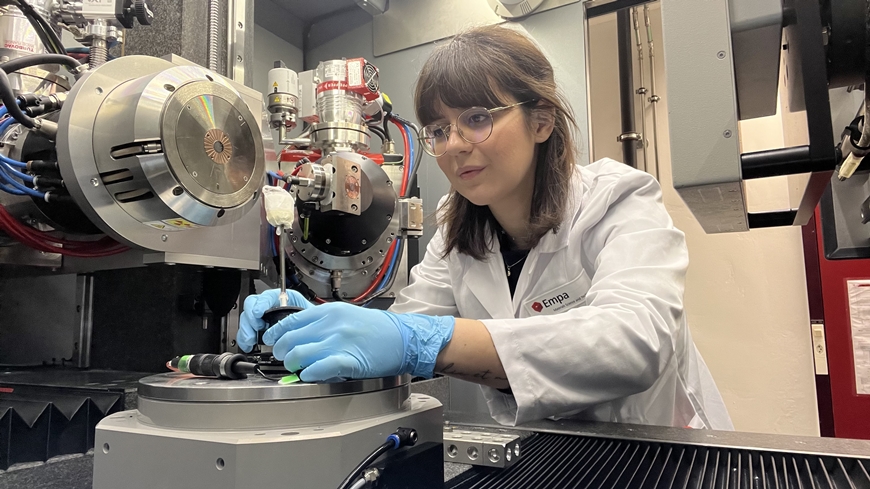Medical technology
Mapping the meniscus
Knee operations on the meniscus cartilage are a frequent procedure on a particularly complex part of the human body. Empa researchers want to provide an improved basis for clinicians in order to reduce the risks of the operation. Using 3D models based on micro-computed tomography analyses in the laboratory, they are mapping the blood vessel network of the meniscus on a nanometer scale.

The knee joint is an extremely complex biomechanical evolutionary achievement. Anyone who has suffered an injury there knows the painful tests of patience during diagnosis and therapy. A non-trivial player in the anatomical orchestra of the compound joint is the meniscus cartilage. Empa researchers are now creating a "3D map" of the precious cartilage.
Crescent-shaped cushion

As a crescent-shaped sliding cushion, the meniscus absorbs shocks and enables smooth movement between the upper and lower leg. However, the two menisci per knee are susceptible to wear and injury. For example, about one in three knees in the population age 40 and older exhibits significant meniscus wear, and about 15 percent of all knee joint accidents involve the meniscus. According to the accident insurance company Suva, these accidents alone cause annual health care costs of over 650 million Swiss francs in Switzerland.
If a surgical procedure is to be performed on the knee, the meniscus is generally not a favorable candidate because the so-called fibrocartilagineous tissue is only supplied with blood in certain sections. Precise knowledge of this valuable vascular plexus is helpful to improve healing chances. Until now, however, information has been based on two-dimensional images of tissue sections. This means that valuable data is lost, for example on the deformability of the tissue or the interconnectedness of the vessels.
"We want to create a three-dimensional "map" through the meniscus with high precision," explains Federica Orellana from Empa's Center for X-ray Analytics in Dübendorf. According to the biophysicist, this could optimize treatment and enable tailored therapies in the sense of personalized medicine.
Below the millimeter limit

With this project, funded by the Swiss National Science Foundation (SNSF), Federica Orellana and principal investigator of the project, Annapaola Parrilli, are striving for a level of accuracy that cannot be achieved with equipment in hospitals. Compared to the millimeter resolution of clinical computer tomography, the micro- and nano-computer tomographs in Empa's laboratories can even go below the micrometer limit. From these radiological images, the researchers create mathematical models that can be used to record and map the density, structure, biomechanical deformability and vascular network of cartilage in space.
Together with clinical partners at the Istituto Ortopedico Rizzoli in Bologna, the Cantonal Hospital Winterthur, and the University of Zurich, the researchers are currently working with a large number of laboratory samples in order to build up as meaningful a data base as possible. Initial computer simulations already show the branching veins in the meniscus with promising precision. The micro-CT images convey the structural complexity of the meniscal tissue and, in the mathematical modeling, also allow further information such as the porosity or how strongly the blood vessels are tortuous.
Federica Orellana is currently working on a 3D atlas of healthy meniscus tissue samples. In a next step, CT images of all kinds of injuries and wear and tear will be integrated into the models. Patients could thus receive essential information on the self-healing potential of the tissue directly during an examination, and the strategies for individual treatment could be optimized. The biophysicist emphasizes that the 3D map can be used for accident patients as well as for wear and tear processes in old age.
Federica Orellana
Center for X-ray Analytics
Phone +41 58 765 6532
PD Dr. Annapaola Parrilli
Center for X-ray Analytics
Phone +41 58 765 6576
annapaola.parrilli@empa.ch

Empa Quarterly#81 Battery research
Being able to store energy is a central pillar of a sustainable energy system, since solar and wind energy are not always available in sufficient quantities when they are needed. Good batteries are indispensable for the energy transition, and thus for a more sustainable world. Empa researchers are developing batteries for different applications, from stationary energy storage to electromobility. They are also working on analyzing and recycling end-of-life batteries.
Read the latest EmpaQuarterly online or download the pdf-version.

Empa Quarterly#82 Mining the Atmosphere
To limit climate change, we need to compensate not only for future emissions, but also for historical ones. One solution would be the "atmospheric vacuum cleaner": we remove the excess CO2 from the atmosphere. But what do we do with it? Instead of extracting the carbon for polymers, medicines, fibers, fuels and the like from crude oil, we use atmospheric CO2. This is the simple – yet extremely challenging in technical terms – idea behind Empa's new research initiative, Mining the Atmosphere.
Read the EmpaQuarterly online or download the pdf-version.

Empa Quarterly#83 Perovskites: Versatile cristals
Over 180 years ago, a curious crystal was discovered in the Ural Mountains. Today, it has given rise to an entire class of materials that is of great interest to researchers: perovskites. What all perovskites have in common is their crystal structure, which gives them unusual properties. By changing the exact composition of the perovskite, scientists can control these properties. Empa researchers are using this promising material to develop solar cells, detectors and quantum dots.
Read the EmpaQuarterly online or download the pdf-version.
-
Share

|
The thinnest layers Yaroslav Romanyuk is heading the Thin Films and Photovoltaics lab at Empa. With his team he develops applications for solar cells, printed circuits or novel solid-state batteries, while supporting a start-up is in the pipeline. |
|
Spying on blood cells Empa researchers have observed living red blood cells transforming into spiky “echinocytes” in real time when treated with high concentrations of ibuprofen using holotomographic microscopy. |








